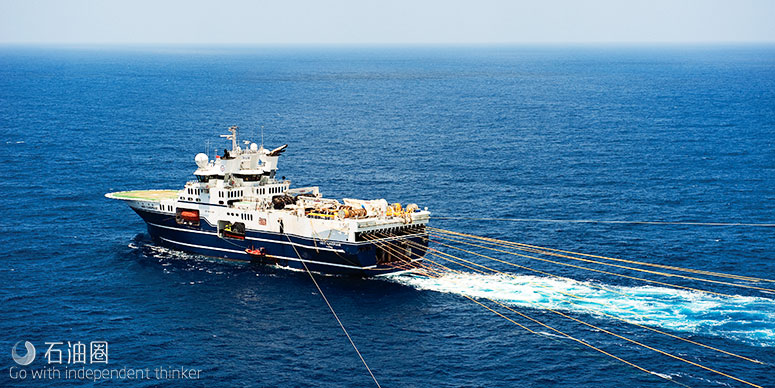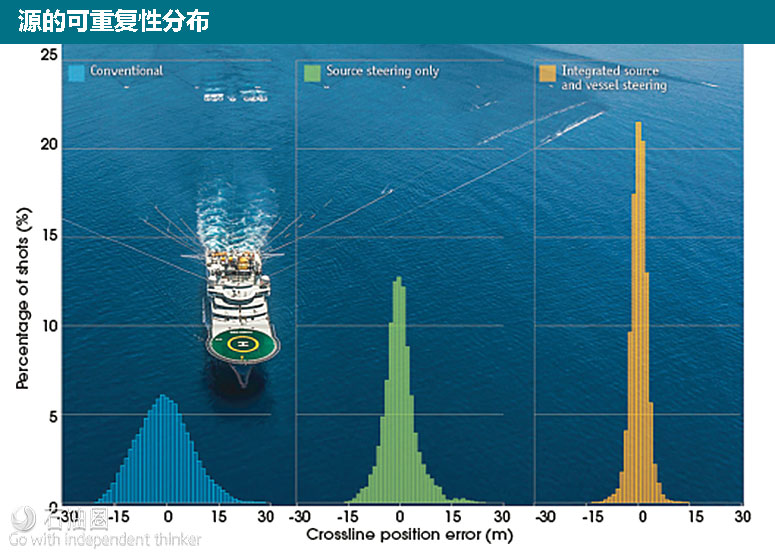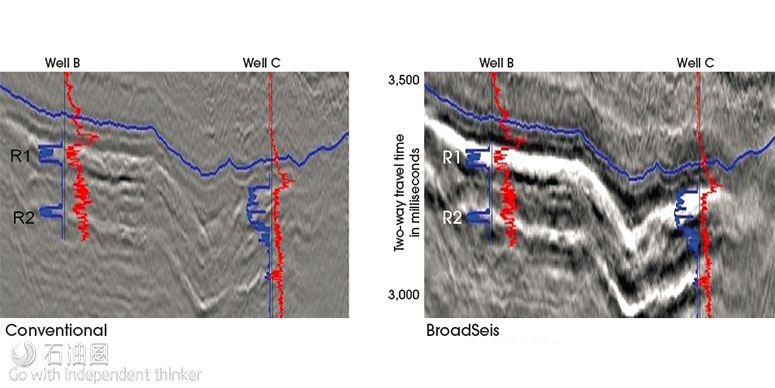
油气生产商已经认识到,4-D地震是一项经济有效的技术。
来自 | E&P
编译 | 白小明 影子
延时(4-D)地震被认为是优化油气生产的关键工具。油气开采会引起储层的变化,导致地震时间、速度和振幅的变化,进而影响反演结果。通过准确重复4-D监测勘查来监测地震信号中的这些变化,可以推导出储层性质的变化。这通过绘制不排水体积且为动态地质和油藏模拟模型提供输入数据,可以提高采收率。
油气生产商已经认识到4-D地震是一项经济有效的技术,有利于成功实施加密井作业和提高采收率,如注气和水平钻井,其附加价值是获取4-D地震数据成本的好多倍。
为了实现这些优势,4-D地震勘查需要将4-D噪声降至最低,以避免遮蔽储层变化造成的差异。更重要的是,源和接收器的位置要能够尽可能准确的复制,以确保记录相同的水下射线路径。4-D高端采集解决方案专注于源转向,最近,CGG开发了集成的船舶和源转向系统,以最大限度地提高可重复性。先进的4-D采集还需要由最新的4-D成像技术来完善,以提供完整的解决方案。
可重复性
工作人员通过4-D作业规划,与船上专家合作,可实现大规模的复制;通过考虑环境条件(洋流、潮汐等)来不断更新采集方案,以定位覆盖区域并优化拖缆(羽状)匹配。然后通过使用诸如Sercel Nautilus等设备的拖缆转向来保持覆盖区范围,上述设备还提供声学定位和深度以确保精确定位。
CGG的集成源和船舶转向系统包含一个自动导向助手,可以定位船舶,使源尽可能靠近预绘图的位置,同时保持采集区的完整性。自动震源转向系统控制剩余横向定位和由膨胀引起的震源位置的短时波动。该系统还控制放炮策略,并按纵向位置而不是时间间隔来触发源启动,从而纠正小尺度误差,如源偏斜。这种系统不同部分的自动集成相对于源转向不仅显著提高了可重复性,更不用说在没有任何源转向的情况下在北海和西非近海两种完全不同的环境中完成了地震数据采集。先进的监测系统和船载质量控制(QC)确保获得最佳的4-D数据。

即使在复杂的北海环境下,通过强大的集成源和船舶转向,显著提高了源定位的可重复性。
源信号
除了源位置的可重复性之外,监测源信号以确保在整个勘查过程中保持一致也非常有意义。在不断变化的海洋环境中,源信号的稳定性可以通过对记录的每炮近场信号近实时QC进行监测。这些记录可以使用专有的反演方法进行远场信号重建,以用于船上和陆上处理,从而提供更精确的反信号和更好的图像。
理想情况下,可采用与基准勘查完全相同的参数和条件完成4-D监测勘查。在实践中,这通常是不可能的,而且在已经有一些多年前完成的监测数据的情况下,它会阻止使用先进的采集技术,所以这么做也不合适,采集技术进步对带宽、照明或多重衰减来说是好事。尽管如此,人们普遍认为源和拖缆位置的可重复性至关重要,应尽可能地能够重复这些位置。即使目前来看对比的优势可能有限,但采集更长的炮检距和更宽的带宽可为以后监测的对比提供一个良好的基础。
多传感器拖缆
最近,多传感器拖缆成为宽带解决方案的一部分,为宽带4-D监测提供了更多选择。这些拖缆使用与单传感器拖缆相同的检波器,其低噪声特性和精确的低频响应使之成为4-D采集的理想选择。使用多传感器拖缆记录意味着可以更直接地向前和向后兼容,因为检波器数据可以与基准勘查相匹配,而y和z加速度计数据可以用于多传感器3-D去虚反射,使用先进的算法来匹配未来针对真实宽带4-D地震的勘查。然而,一般来说,传统的基准勘查通常使用虚反射波场消除法来去除虚反射,并且匹配到传统数据信噪比所允许的最大带宽。这些算法的成熟使得能够进行基准和监测勘查的3-D联合去虚反射(称为4-D去虚反射),并且能够充分处理海面工况的变化。
这种技术最终形成了常规和宽带采集解决方案,这些解决方案可与所有其他拖缆4-D采集技术兼容。尽管如此,宽带采集仍然是最好的系统,能够成功实现去虚反射,并保留最大的带宽以便与未来的勘查相匹配。宽带4-D地震可以提供强化储层建模,3-D宽带的所有优势也适用于4-D。例如,没有旁瓣更尖锐的子波提供了高分辨率的4-D信号,没有干扰且不会屏蔽地震细节。无重影子波消除了数据的海面特征,因此可以提供更可靠的幅度与炮检距,从而实现准确的同时4-D反演和更好的低频内容以获得定量反演结果。

如果储层在地震数据中可见,则可以更好地检测到4-D信号(储层变化),尤其是在用低频变化解释4-D信号的情况下。
增强的低频改善了对储层非均质性的描述,并且能够以更定量的方式检测由压力和/或饱和度变化引起的4-D信号。当有来自油井和井之间的低频带来的更清晰的油藏图像时,将更容易检测到4-D信号,尤其是在4-D信号是通过低频变化解释的情况下。
4-D处理和成像的技术进步一直致力于优化针对最小4-D差异的序列。基于采集知识的修正(如源和水层速度)被用于消除4-D噪声。在处理过程中储层域属性将定期强化标准的QC。可以设计4-D的成本函数,以进一步衰减不可重复的噪声,同时保留固有的4-D信号。虽然详细的4-D处理和成像可以帮助改善采集中缺乏可重复性所带来的挑战,但采集越匹配,4-D信号越好,4-D噪声也越趋于降低,从而降低虚假信号的几率。一种极端情况证明了这一点,如永久埋在水下的海底电缆,被用于高频率监测以及提供高度的重复性,以监测油藏的微小变化。然而,先进的转向技术可以提供非常好的重复性,并结合最先进的4-D成像技术,为需要低频率监测的油藏提供可靠的4-D信号。
您也有让人挠头的难题需要解决,或是优质技术想要找应用市场吗?如果有的话,欢迎联系小编微信或邮箱,也许能找到一剂良药。
二丫:022-65771089;131-3255-0596
For English, Please click here (展开/收缩)
Time-lapse (4-D) seismic is recognized as a key tool for optimizing hydrocarbon production. Extraction of hydrocarbons induces changes in the reservoir that cause changes in seismic timing, velocity and amplitude, which in turn affect inversion results. Monitoring these changes in the seismic signal by accurately repeating 4-D monitor surveys enables changes in reservoir properties to be derived. This enhances recovery by enabling undrained volumes to be mapped and providing input to dynamic geological and reservoir simulation models. Hydrocarbon producers have recognized 4-D seismic as an economic success, contributing directly to successful infill wells and enhanced recovery techniques, such as gas injection and horizontal drilling, with the added value being several times the cost of the 4-D seismic data.
For 4-D surveys to deliver these advantages, 4-D noise needs to be minimized to avoid obscuring differences caused by changes in the reservoir. More importantly, the positions of the sources and receivers need to be replicated as closely as possible to ensure that the same subsurface raypaths are recorded. High-end acquisition solutions for 4-D have focused on source steering and, more recently, CGG has developed integrated vessel and source steering to maximize repeatability. Advanced 4-D acquisition also needs to be complemented by the very latest 4-D imaging technology to deliver a complete solution.
Repeatability
Large-scale repeatability is achieved through 4-D operational planning, working with experts onboard to prepare and constantly update acquisition plans by taking environmental conditions (current, tide, etc.) into account to position the spread and optimize streamer (feather) matching. The geometry of the spread then is maintained through streamer steering using equipment such as Sercel Nautilus units, which also deliver acoustic positioning and depth to ensure accurate positioning.
CGG’s integrated source and vessel steering system consists of an automatic steering assistant to position the vessel so that the source is as close as possible to the pre-plot position while maintaining the integrity of acquisition geometry. Residual crossline positioning and short-period perturbations of the source position caused by swell are controlled by the automatic source steering system. The system also controls the shooting strategy and triggers the source firing to respect in-line positions rather than time intervals, correcting for smaller scale errors such as the skew of the sources. This automatic integration of the different parts of the system has delivered considerable improvements in repeatability over source steering only, let alone acquisition without any source steering at all, in the very different environments of the North Sea and offshore West Africa. Advanced monitoring systems and onboard quality control (QC) ensure acquisition of the best possible 4-D data.
Source signature
In addition to repeatability of source positions, it also is beneficial to monitor the source signature to ensure it is consistent throughout the survey. The stability of the source signature in the changing sea environment is monitored via shot-by-shot near realtime QC of the recorded near-field signature. These recordings enable far-field signature reconstruction using a proprietary inversion method for use in onboard and onshore processing, delivering more accurate designature and therefore better images.
Ideally, a 4-D monitor survey would be acquired with exactly the same parameters and under the same conditions as the base survey. In practice, this often is not possible and, in cases where there are already several monitors dating back to the last century, would not really be desirable as it would prevent the use of any advances in acquisition technology, which might deliver benefits in terms of bandwidth, illumination or multiple attenuation. Nevertheless, it is generally agreed that repeatability of the source and streamer positions is of prime importance and that these should be replicated as closely as possible. Acquisition of additional longer offsets and broader bandwidths can be beneficial in providing a good basis for comparison with the next monitor, even if the benefit for the current comparison may be limited.
Multisensor streamers
Multisensor streamers recently have joined the toolbox of broadband solutions, providing an additional option for broadband 4-D monitoring. These streamers use the same hydrophone components as single-sensor solid streamers, whose low noise characteristics and precise low-frequency response make them ideal for 4-D acquisition. Recording with multisensor streamers means that forward and backward compatibility can be straightforward because the hydrophone data can be matched to the base survey while the y and z accelerometer data can be used for multisensor 3-D deghosting using advanced algorithms to match future surveys for true broadband 4-D seismic. However, in general, conventional base surveys are usually deghosted using ghost wavefield elimination and matched to as broad a bandwidth as the signal-to-noise ratio of the conventional data allow. The maturity of these algorithms allows the joint 3-D deghosting of base and monitor surveys (known as 4-D deghosting) and enables variations in the sea surface state to be handled fully.
This technique results in acquisition solutions, both conventional and broadband, that are forward and backward compatible with all other towed-streamer 4-D acquisition techniques. Nevertheless, broadband acquisition remains the best system to enable successful deghosting and to preserve the broadest possible bandwidth for matching to future surveys. Broadband 4-D seismic can deliver enhanced reservoir modeling as all the benefits of broadband in 3-D also hold true for 4-D. For example, sharper wavelets without sidelobes provide a high-resolution 4-D signal with no interference and masking of seismic detail. Ghost-free wavelets remove the imprint of the sea surface on the data and hence deliver more reliable amplitude versus offset for accurate simultaneous 4-D inversion combined with better low-frequency content for quantitative inversion results.
The enhanced low frequencies improve the characterization of reservoir heterogeneities and enable the detection of 4-D signal due to pressure and/or saturation changes in a more quantitative manner. When there are clearer images of the reservoir from low frequencies at and between wells, 4-D signals will be detected more readily, especially where the 4-D signal is explained by low-frequency changes.
Advances in 4-D processing and imaging have been geared toward optimizing the sequence for minimal 4-D difference. Corrections based on knowledge of the acquisitions, such as the sources and the water-layer velocities, are used to deterministically remove 4-D noise. Standard QCs are regularly augmented by reservoir-domain attributes during the processing. The cost functions for 4-D can be designed to further attenuate nonrepeatable noise while preserving coherent 4-D signals. Although careful 4-D processing and imaging can help to ameliorate challenges caused by lack of repeatability in acquisition, the closer the acquisition is matched, the better the 4-D signal and the lower the 4-D noise tends to be, reducing the chance of false signals. This is demonstrated in the extreme case where permanent installations of buried subsea cables are used for monitoring at frequent intervals and deliver exceptionally high levels of repeatability for monitoring very small changes in the reservoir. However, advanced steering techniques can deliver very good repeatability and, combined with state-of-the-art 4-D imaging technology, provide reliable 4-D signals for reservoirs where less frequent monitoring is required.
未经允许,不得转载本站任何文章:

 石油圈
石油圈


